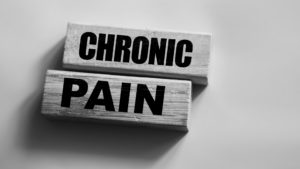Chronic pain is classified as a pain or discomfort that is ongoing and lasts three months or longer. It is typically caused by an underlying chronic condition, although not always. Unlike pain from pulling a muscle or stubbing your toe that goes away after the injury is healed, chronic pain can last years if not managed by a physician.
This type of pain is not always constant, but it does disrupt daily life by preventing patients from doing what they love.

Things to Know About Chronic Pain
What Causes Chronic Pain
For many people, chronic pain begins after an injury or trauma. Other times, it can begin without an obvious cause. Some of the most common causes of chronic pain are:
-
- Previous surgeries or injuries – Old injuries can cause nerve damage because they either were not treated properly the first time or they healed incorrectly.
- Back problems – There are a variety of back conditions that contribute to chronic pain, such as SI Joint Pain, herniated discs, deterioration of the spinal column, spinal cord compression, and many others.
- Migraines or other types of headaches – While chronic headaches are difficult to diagnose, common causes are inflammation, blood pressure issues, stress, or hormone changes in women.
- Arthritis – Arthritis is one of the most common causes of chronic pain and can cause limb deformities, loss of range of motion, stiffness, and inflammation.
- Nerve damage – An injury, accident, or infection can cause chronic nerve pain (neuropathic pain). When nerves are damaged, they are unable to function properly and that oftentimes leads in a loss of communication between body parts and the brain.
- Fibromyalgia – Fibromyalgia is a musculoskeletal condition that causes widespread muscle pain throughout the body. Studies show that this condition worsens pain by affecting the way your brain processes these signals.
How Does Chronic Pain Affect My Body?
When pain is experienced for a long amount of time, your nociceptors go into overdrive and become more sensitive to pain. They produce lower level signals, making you feel more pain than you are actually experiencing. This is problematic because your body is likely not harmed, but your pain receptors exaggerate the pain.
When an injury or trauma occurs, the area’s pain sensors (nociceptors) are “turned on.” They send an electrical current that travels along the nervous system until it reaches the brain. Your brain understands that signal and sends the message that you are hurt. In chronic pain patients, the nerves continue sending the pain signals to the brain, even after the injury is healed.
Why Are Narcotics Bad for Chronic Pain?
Narcotics, in chronic pain patients, create a cyclical relationship and dependency. At first, these drugs may relieve pain by attaching themselves to your brain’s endorphin receptors. However, after any length of time, the receptors become dependent on the medication’s effect. The brain limits the amount of endorphins it produces, reducing the body’s natural painkillers. Without natural endorphins, narcotics have to be taken to maintain a level of comfort.
This causes problems when the patient is no longer prescribed these medications from a physician, because their body has become dependent on the narcotics’ effect on the brain. Your brain and body need that chemical to function regularly. Stopping or lowering the dose can cause your body to react poorly, including nausea, shakes, headaches, and other serious problems.
Available Treatment Options
Treatment for chronic pain will depend on your pain’s severity and your physician’s diagnosis. The root cause of the pain will also determine the treatment plan your physician designs.
Medications for Chronic Pain
Medication can be helpful to patients who suffer from chronic pain. Over-the-counter pain relievers such as acetaminophen (Tylenol) or NSAIDs like aspirin and ibuprofen are useful in reducing inflammation and stiffness that worsens chronic pain.
Physicians do not recommend opioids due to the aforementioned risk of dependency and danger of abuse.
Analgesics such as antidepressants and anticonvulsants are useful in chronic pain that is caused by nerve-related disorders. This includes pinched nerves, sciatica, and herniated discs.
Procedures for Chronic Pain
If the chronic pain worsens and other pain relief methods have not been successful, your physician may recommend a medical procedure.
Some examples include:
- Electrical stimulation
- Nerve block injections
- Acupuncture
- Facet joint injection
- DRG therapy
- Spinal cord stimulation
There is no cure for chronic pain, but when managed effectively, patients can live their lives relatively pain-free and comfortably.
Under a pain management specialists’ supervision, it is recommended that patients who are looking to reduce chronic pain make lifestyle changes in order to promote health and wellbeing. This includes being active, incorporating low-impact cardio into their daily routine, eating a healthy diet, and getting enough sleep.
Learn more about pain management and how the team at Progressive Pain Management work with their patients to create a personalized pain management plan that works best with their lifestyle and needs.
Fill out the form below to get started today.
When you are affected by pain, daily life, normal activities, and hobbies can become a challenge. Even the amount of sleep you get, the thoughts you have, and basic daily tasks can be negatively affected by pain.
Your quality of life and desire to resume regular activities plays an important role in maintaining your health and managing your pain. There are some positive changes you can make to your lifestyle and simple changes to your daily life that make managing your pain easy.

Tips for Living with Chronic Pain
Lifestyle Changes that Make Living With Chronic Pain Easier
Staying Active
Exercise can help those in pain find the relief they are looking for. Cardio exercise utilizes large groups of muscles and raises your heart rate. This combination releases endorphins. Endorphins are your body’s natural opiate (painkiller). Studies show that exercising for 30-45 minutes of low-intensity aerobic exercise is recommended and can help reduce pain.
Be sure to talk to a doctor before beginning any new exercise program.
A Good Night’s Sleep
Pain interferes with sleep – that’s a no brainer. When you are in pain, you are unable to achieve proper REM cycles and relax enough to get uninterrupted sleep. Pain can cause issues when falling asleep or staying asleep throughout the night.
Certain medications can also cause problems with sleep. If your medication causes drowsiness and fatigue, you may be more inclined to sleep during the day which can mess with your sleep at night. Getting the right amount of sleep at night is crucial to how your body copes with pain and how your body harnesses its energy levels.
Here are some ways to sleep better:
- Stick to a Routine: Creating a sleep routine can help you sleep better. Going to bed at the same time and setting an alarm for the same time every day can help train your body to get more meaningful rest.
- Watch What You Eat and Drink: Certain beverages – such as alcohol or caffeine – can affect your sleep patterns. Heavy meals have the same affect. If you have a snack before bed, eating something healthy like almond butter on toast, crackers and cheese, or nuts and fruit are great alternatives.
- Relaxation: Practicing relaxation techniques before bed can help get your mind and body prepared for a restful sleep. Try things like listening to soothing music, practicing deep breathing, and writing in a journal.
Reduce Stress Factors
Stress and pain go hand-in-hand. Your body may react in different ways when there is stress involved, such as tense muscles or headaches. This can be avoided by reducing stressors and managing stress levels.
Stress can cause negative impacts on your work ethic, eating habits, mood, and relationships. By keeping track of what stresses you out and considering how it affects your life. By eliminating or minimizing the stressors in your life, you may find ways to make your days or weeks go smoother.
Taking your life back from the pain caused by chronic diseases can be solved by adjusting your routine and activities. Contact the team at Progressive Pain Management to learn how to manage your chronic pain. Use the form below to get started.
People who live with chronic joint pain know how debilitating it can be. Joint pain makes doing daily activities difficult and typically has a negative effect on the quality of life. It can steal away joy from doing the things they love and spending time with loved ones.
Chronic joint pain affects approximately 100 million Americans each year. Fortunately, there are exercises and self-care practices that help reduce and maintain pain. Exercises are designed to reduce inflammation, increase mobility, strengthen joints, and regain range of motion. Ideally, by implementing an exercise routine, there is no need for medication to manage the pain.
Working with a physical therapist or pain specialist is a great way to learn the proper exercise techniques that will help manage and reduce chronic pain. It’s important to remember not to force exercise or continue if it worsens your pain. Listen to you body and do what feels best!

Exercises to Help Reduce Chronic Joint Pain
Always consult your doctor before starting any exercise program.
Types of Exercises to Reduce Chronic Joint Pain
Stretching
Stretching helps relieve tension and stiffness that causes joint pain. Stretching does not require any equipment, so these can be done at-home, on-the-go, or even at work. Stretches are designed for certain areas of pain, like knee pain, neck pain, and back pain.
Cardio
Cardiovascular exercises have a large impact on chronic pain and reducing symptoms that are caused by living with pain. Little-to-no equipment is needed for cardio exercises and they are relatively easy to incorporate into your daily life. Walking is the easiest way to get moving and increase your heart rate, endurance, and strength. If walking is challenging at first, start with short walks and slowly build up the distance overtime.
Swimming and water aerobics are another great cardio option for those living with chronic pain. Being in the water takes the pressure off your joints so you can exercise with ease. This is especially important for patients with low-mobility. Moving in the water adds natural resistance while no additional stress or pressure on your joints is present. Being in the water is often therapeutic, too. Improving your mood is critical to managing chronic pain.
Low-Impact Group Classes
Low-impact exercises are a great way to build muscle strength to better support joints that cause pain. Group setting classes, such as cycling or aerobics, can be beneficial to pain patients. Group classes are usually designed around a certain level of ability, meaning pain patients can take classes that best suit their needs and functions. Group settings are also great for accountability, which is important when trying to exercise regularly.
Cycling, for example, is a smoother motion for the joints than jogging, which can cause further damage and pain. If your pain levels allow, trying cycling a few times a week. The pedaling motions and breathing rhythms are excellent for increasing oxygen flow to the muscles and releasing endorphins that reduce chronic pain.
Balance Exercises
Exercises that focus on balance, core strength, and self-awareness like Yoga, Tai Chi, and Pilates are excellent for managing pain. They improve coordination and balance, which helps increase a sense of where joints are located and how to relieve tensions and pressure on those joints. These exercises include moves that increase flexibility and range of motion. This can loosen joints, which improves their function.
These exercises will help teach proper posture and body positions that align your joints and muscles, in hopes that your pain will be reduced. At Progressive Pain Management, our team can help create a plan incorporating exercise with interventional pain management techniques.
Fill out the form below to learn more.

